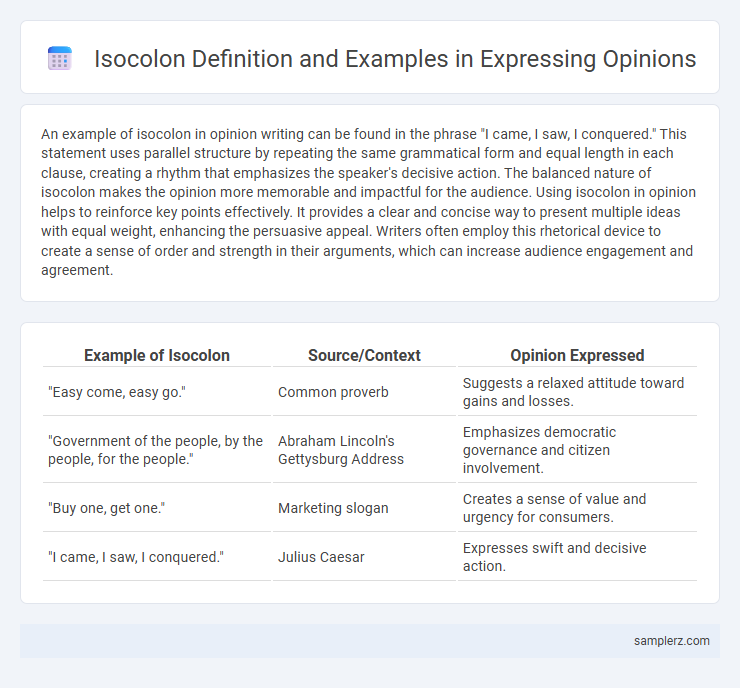An example of isocolon in opinion writing can be found in the phrase "I came, I saw, I conquered." This statement uses parallel structure by repeating the same grammatical form and equal length in each clause, creating a rhythm that emphasizes the speaker's decisive action. The balanced nature of isocolon makes the opinion more memorable and impactful for the audience. Using isocolon in opinion helps to reinforce key points effectively. It provides a clear and concise way to present multiple ideas with equal weight, enhancing the persuasive appeal. Writers often employ this rhetorical device to create a sense of order and strength in their arguments, which can increase audience engagement and agreement.
Table of Comparison
| Example of Isocolon | Source/Context | Opinion Expressed |
|---|---|---|
| "Easy come, easy go." | Common proverb | Suggests a relaxed attitude toward gains and losses. |
| "Government of the people, by the people, for the people." | Abraham Lincoln's Gettysburg Address | Emphasizes democratic governance and citizen involvement. |
| "Buy one, get one." | Marketing slogan | Creates a sense of value and urgency for consumers. |
| "I came, I saw, I conquered." | Julius Caesar | Expresses swift and decisive action. |
Defining Isocolon: A Stylistic Device in Opinion Writing
Isocolon is a rhetorical device characterized by parallel structures of equal length and rhythm, enhancing clarity and impact in opinion writing. This stylistic technique involves balancing phrases or clauses to create a harmonious and persuasive effect, such as Julius Caesar's "Veni, vidi, vici." Employing isocolon in opinion pieces strengthens arguments by making statements more memorable and emphatic, thereby engaging readers effectively.
Why Isocolon Enhances Persuasive Arguments
Isocolon enhances persuasive arguments by creating rhythm and balance, which makes statements more memorable and impactful. The repetition of parallel structures appeals to the audience's sense of harmony and reinforces key points. This rhetorical device effectively emphasizes ideas, strengthening the overall persuasiveness of the argument.
Classic Examples of Isocolon in Famous Opinions
Famous opinions often showcase classic examples of isocolon, employing balanced, parallel structures to emphasize key points succinctly. Winston Churchill's declaration, "We shall fight on the beaches, we shall fight on the landing grounds," exemplifies isocolon through its rhythmic repetition, enhancing persuasive impact. Similarly, Julius Caesar's phrase, "Veni, vidi, vici," remains a timeless isocolon that conveys decisive action with elegant symmetry.
Crafting Conviction: Isocolon in Editorials
Isocolon, a rhetorical device characterized by parallel structures of equal length, enhances persuasion in editorials by creating rhythm and emphasis. Editorial writers often employ isocolon to strengthen arguments, making statements more memorable and compelling. Crafting conviction through balanced phrases engages readers emotionally, reinforcing the editorial's core message effectively.
Isocolon for Emphasis: Making Opinions Memorable
Isocolon enhances the impact of opinions through balanced, parallel structures that create rhythm and emphasis, making statements more memorable. For example, Julius Caesar's phrase "I came, I saw, I conquered" uses isocolon to deliver a powerful, concise message that resonates deeply. Employing isocolon in opinion writing reinforces key points by appealing to readers' sense of order and clarity, increasing the persuasive effect.
The Role of Isocolon in Rhetorical Impact
Isocolon enhances rhetorical impact by creating rhythm and balance in speech, making arguments more memorable and persuasive. The repetition of parallel structures, such as in Julius Caesar's "Veni, vidi, vici," exemplifies how isocolon strengthens emphasis and clarity. This technique engages audiences by reinforcing key points through symmetrical phrasing, thereby amplifying the speaker's authority and emotional appeal.
Opinion Leaders and Their Use of Isocolon
Opinion leaders often employ isocolon to enhance the impact of their messages, using parallel grammatical structures to make arguments more memorable and persuasive. For instance, political figures frequently use balanced phrases like "Ask not what your country can do for you--ask what you can do for your country" to inspire action and unity. This rhetorical strategy amplifies their influence by appealing emotionally and intellectually to diverse audiences.
Isocolon vs. Other Rhetorical Devices in Opinions
Isocolon stands out in opinion writing by creating balanced, rhythmic phrases that enhance clarity and memorability, such as "government of the people, by the people, for the people." Compared to anaphora or antithesis, isocolon relies on parallel structure with equal length clauses, making arguments more persuasive through rhythm rather than repetition or contrast. This equal length feature distinguishes isocolon as a powerful tool to emphasize unity and strength in opinion statements.
Elevating Opinion Pieces: The Power of Balanced Phrases
Isocolon enhances opinion pieces by creating balanced phrases that reinforce key arguments with rhythmic precision, making the message more persuasive and memorable. This technique, exemplified by parallel structures of equal length and emphasis, appeals to readers' sense of harmony and clarity. Through isocolon, writers elevate their viewpoints, ensuring their opinions resonate with compelling symmetry and force.
Writing Opinionated Isocolon: Tips and Techniques
Writing opinionated isocolon enhances persuasive impact by balancing parallel structures with equal length, creating rhythmic emphasis that reinforces key points. Effective tips include maintaining syntactic symmetry, using concise wording, and aligning ideas for clarity and forceful expression. Mastering these techniques helps writers deliver opinions with memorable cadence and compelling strength.

example of isocolon in opinion Infographic
 samplerz.com
samplerz.com